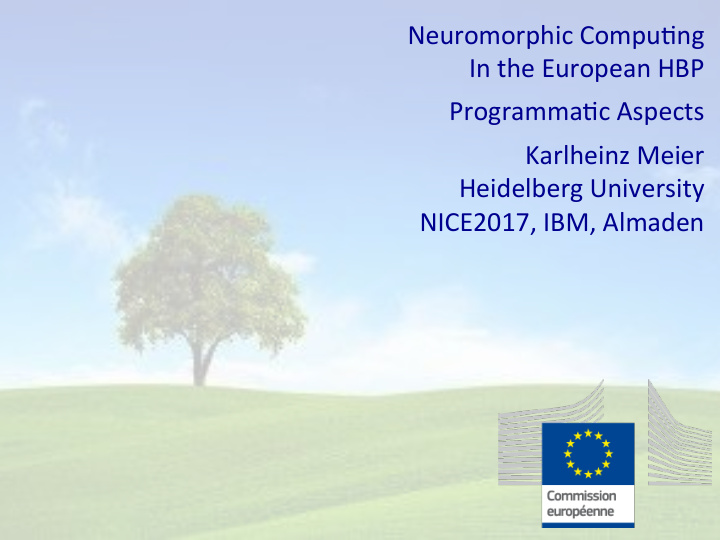



Neuromorphic Compu-ng In the European HBP Programma-c Aspects Karlheinz Meier Heidelberg University NICE2017, IBM, Almaden
European Framework Funding Program Horizon 2020 Total Budget 2014- 2020 (project start dates) : 79 B€ Excellence in Science : 24 B€ ERC (individual researchers) : 13 B€ Marie-Curie (mobility) : 6.1 B€ Infrastructures : 2.2 B€ Future Emerging Technologies (FET) : 2.7 B€ FET open : approx. 1.1 B€ FET proac-ve : approx. 0.8B€ FET flagships : approx. 0.8B€ Graphene : approx. : 0.4 B€ Human Brain Project : approx. : 0.4 B€ NEW : Quantum Technologies : ?? Neuromorphic : approx. : 0.025 B€
SP9 F uture E merging T echnologies actions are expected to initiate radically new lines of technology through unexplored collaborations between advanced multidisciplinary science and cutting-edge engineering. HBP Neuromorphic Computing Systems will use brain- like principles of computing and architectures to achieve high-energy efficiency and fault tolerance, together with learning and cognitive capabilities comparable to those of biological organisms. SP9 Neuromorphic Computing Platform – HBP SGA2 Planning, Malaga – Feb 2017 Slide Co-funded by ! the European Union !
Funding and Contractual Structure of the HBP Pilot Phase Funded through 12 months Framework Program 7 Ramp-up phase October 2013 – March 2018 Specific grant agreement SGA1 Funded through Start April 2016 – March 2018 Horizon 2020 Specific grant agreement SGA2 Project specific Start April 2018 – March 2020 Framework Partnersgip Currently under prepara-on agreement (FPA) APPROVED .....
... likewise for the Human Brain Project, even though it is s-ll at an early stage. Developments such as the neuromorphic compu-ng architectures have scope for high economic impact ...
The basic idea of the Human Brain Project From Science to Infrastructures to Science and Innovation Co- HBP Platforms – Unified access through Design Collaboratory Neuroinformatics Brain Simulation HPAC Mouse Medical Human Neuromorphic Neurorobotics Informatics Cognition Theory Knowledge Application in About the brain brain technology Basic Science Innovation HBP Neuroscience What USERS get from the platforms
Click to edit Master title style HBP Neuromorphic Computing Machines • Click to edit Master text styles MANY-CORE NUMERICAL MODEL SYSTEM – Second level 0.5 – 1 Million ARM processors – address-based, small packet, • Third level asynchronous communica-on – real--me simula-on Loca-on : Manchester (UK) – Fourth level PHYSICAL MODEL SYSTEM Local analog compu-ng with 4 Million neurons and 1 Billion synapses – binary, asynchronous communica-on – x 10 000 accelerated emula-on Loca-on : Heidelberg (Germany)
HBP neuromorphic computing - The 1 st generation SP9 Concepts developed around 2005 ... state-of-the-art ... Now doing the next step in HBP SGA1: Proof of concept – SGA2: Operational 2nd generation systems SP9 Neuromorphic Computing Platform – HBP SGA2 Planning, Malaga – Feb 2017 Slide Co-funded by ! the European Union !
Next genera-on of NM compu-ng in the HBP BrainScales-2 SpiNNaker-2 Flexible local learning 4-core Quad Processing Element On-the-fly network reconfigura-on 25 GIPS/W on a single die Structured neurons Floa-ng point precision Dendri-c computa-on True random numbers SerDes SerDes SerDes Processing Shared Memory Router Element Processing Element Processing Processing MCU Shared Memory Element Element Memory Interface SerDes SerDes SerDes SerDes Today : Working prototypes 2020 : Opera-onal systems Overall goal : Learning cogni-ve machines
Organisation of work in NMC SP9 OPERATION – MACHINES – PRINCIPLES - APPLICATIONS 9.1 Software services and platform op. Andrew Davison CNRS 9.2 Next generation BrainScaleS machine Johannes Schemmel Heidelberg 9.3 Next generation SpiNNaker machine Steve Furber Manchester 9.4 Computational principles Wolfgang Maass Graz 9.5 Applications and Benchmarks Michael Schmuker Hertfordshire 9.6 Management and training Björn Kindler Heidelberg Subproject leader Karlheinz Meier Subproject co-leader Steve Furber Goal : Learning Cognitive Machines SP9 Neuromorphic Computing Platform – HBP SGA2 Planning, Malaga – Feb 2017 Slide 10 Co-funded by ! the European Union !
Presence of the HBP at NICE 2017 MON K. Meier The BrainScaleS physical model machine – From commissioning to real world problem solving MON E. Müller DEMO Neuromorphic Hardware In The Loop: Training a Deep Spiking Network on the BrainScaleS Wafer-Scale System TUE S. Furber SpiNNaker: Large-scale Real--me Neural Simula-on TUE W. Maass How Can Networks of Spiking Neurons Wire Themselves Up For a Specific Computa-onal Task? WED J. Schemmel Training and Plas-city Concepts of the BrainScaleS Neuromorphic Systems
Recommend
More recommend